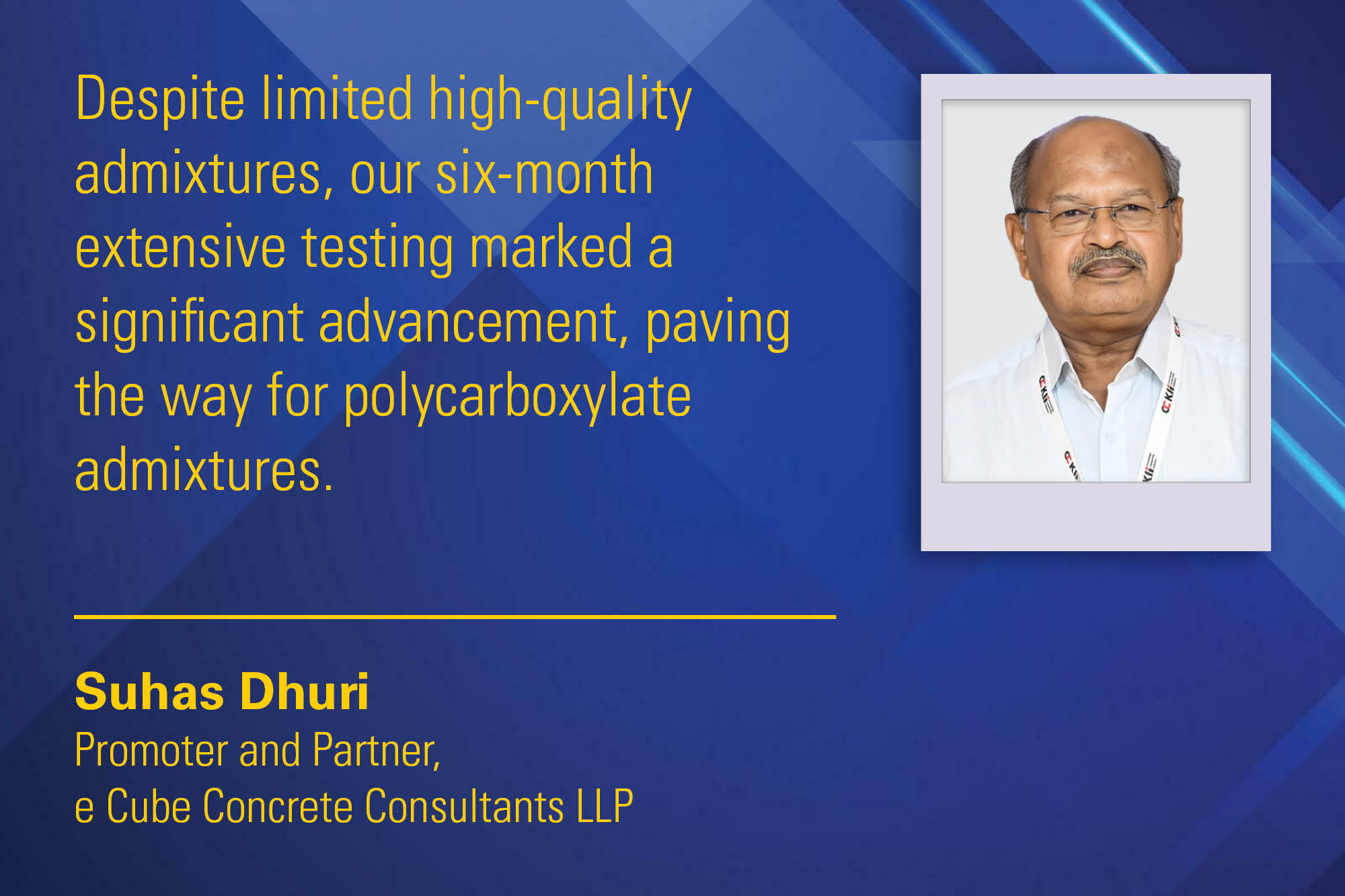Advances in high-performance concrete and admixture strategies
By Staff Report | September 11, 2024 4:32 pm SHARE

Suhas Dhuri, with 45 years in concrete innovation, has pioneered high-performance solutions, including M-75 grade concrete and ultra-thin pavements, and continues to advance concrete technology.
Suhas Dhuri began his civil engineering career with the ACC R&D section in 1980, where he worked on numerous R&D projects and concrete development. He has almost 45 years of expertise in the concrete sector. The Suhas switched to ready-mix concrete in 1995, and by 1998, they were part of the team that developed one of India’s first ready-mix applications. Creating M-75-grade concrete for the JJ flyover was a watershed moment in his career, as it was both innovative and unique at the time. While M-90-grade concrete is now widely used, producing M-75 back then posed major obstacles.
Dhuri founded his concrete consulting firm in 2005, offering technical assistance to the concrete sector. As concrete technology has advanced considerably, people are increasingly required to manage it properly—an act formerly held by RCC consultants. Suhas’ consulting meets this requirement by providing professional services for various projects around India.
High-Performance Concrete (HPC)
According to him, high-performance concrete is critical to increasing the longevity of construction projects. Structural issues generally necessitate frequent repairs; however, high-performance concrete can greatly reduce the need for these repairs, extending the structure’s life.
Recognising the advantages of high-performance concrete, MSRDC discovered that employing M-75-grade concrete may produce better outcomes than normal concrete, a revolutionary notion at the time. They introduced worldwide tests for this concrete, and Mr Dhuri’s team tested it extensively for six months despite the limited availability of high-quality admixtures.
Since then, chemical admixtures have advanced dramatically, with the development of third- and fourth-generation polycarboxylate (PC) admixtures. Initially, they focused on sulfonated naphthalene formaldehyde (SNF) admixtures.
Using his significant R&D knowledge, he persuaded Bharat Diamond Bourse that concrete is a sophisticated substance that demands management expertise. They displayed a thorough understanding of raw components and their impacts on concrete. As a result, Bharat Diamond Bourse decided to detach the concrete supply from the primary contractor and assign it to Suhas’ team. In 1993, they developed high-performance, long-lasting concrete for the Bharat Diamond project.
Ultra-thin white topping
He says traditional pavements typically employ M40 grade concrete, as specified by the Central Building Research Institute (CBRI), with a thickness of approximately 300 mm. Using hybrid concrete, such as M60, the pavement thickness can be decreased to 50–75 mm. This provides a significant advantage, allowing for the restoration of old roads while reducing the risk of cracking. Mr Dhuri’s team initially implemented this strategy in Thane in 2006, and the road has operated admirably since then, with no potholes. This result demonstrates the significant advantages of ultra-thin, broad pavement overlays.
Thermal cracking
Controlling the temperature is crucial. The first stage is to design a concrete mixture. Ordinary Portland Cement (OPC) produces a quantity of heat during hydration. To address this, it is recommended to lower the amount of OPC used and mix additional cementitious elements that can reduce heat generation while keeping the requisite strength. Another option is to use an ice-concrete mix and modify the other parameters accordingly. The first step in this method is to create a concrete mix that includes a substantial amount of extra cementitious elements and high-performance admixtures.
Rheological properties
Admixtures interact with cement particles by generating charges that repel each other, enhancing workability without altering water content. However, adding viscosity-modifying compounds significantly affects the concrete’s rheological properties. In certain cases, these advanced admixtures can eliminate the need for extra energy in concrete consolidation, showcasing their unique ability to create self-compacting concrete, concludes Mr. Dhuri.
Cookie Consent
We use cookies to personalize your experience. By continuing to visit this website you agree to our Terms & Conditions, Privacy Policy and Cookie Policy.




































-20240213125207.png)

























